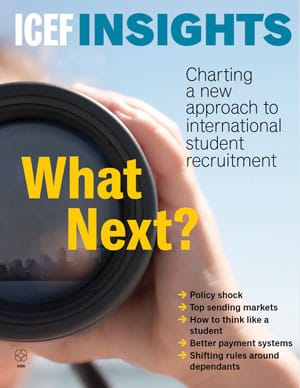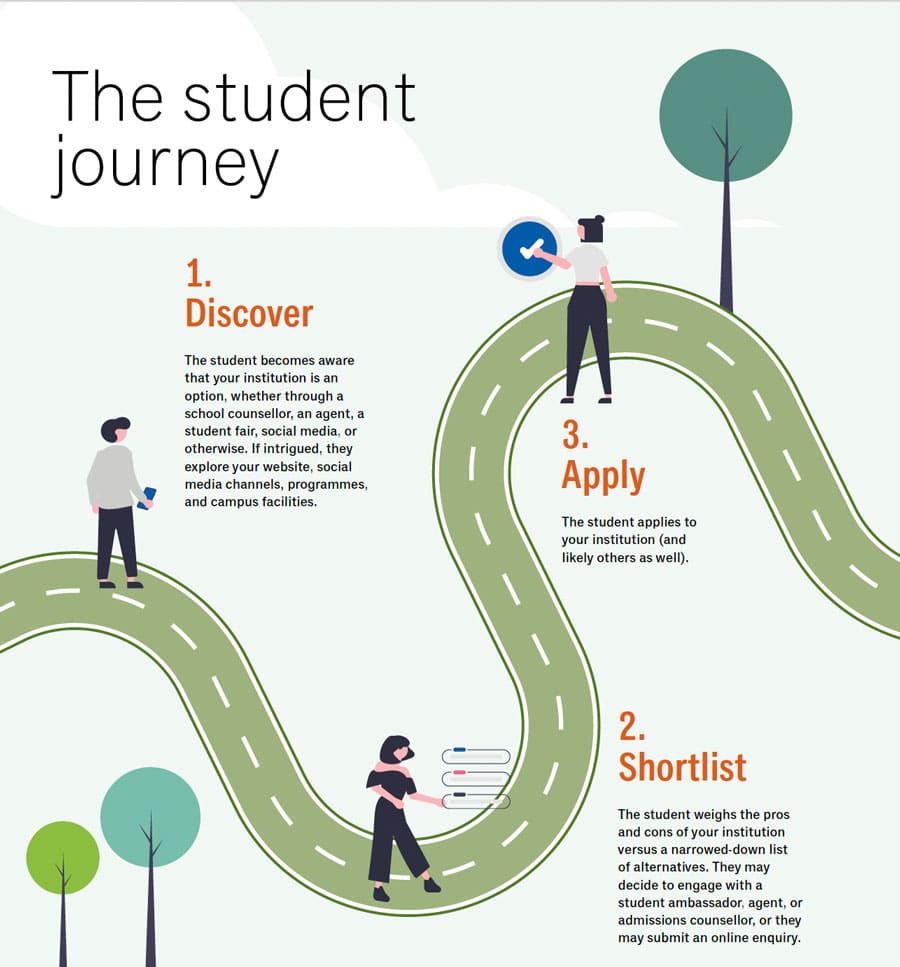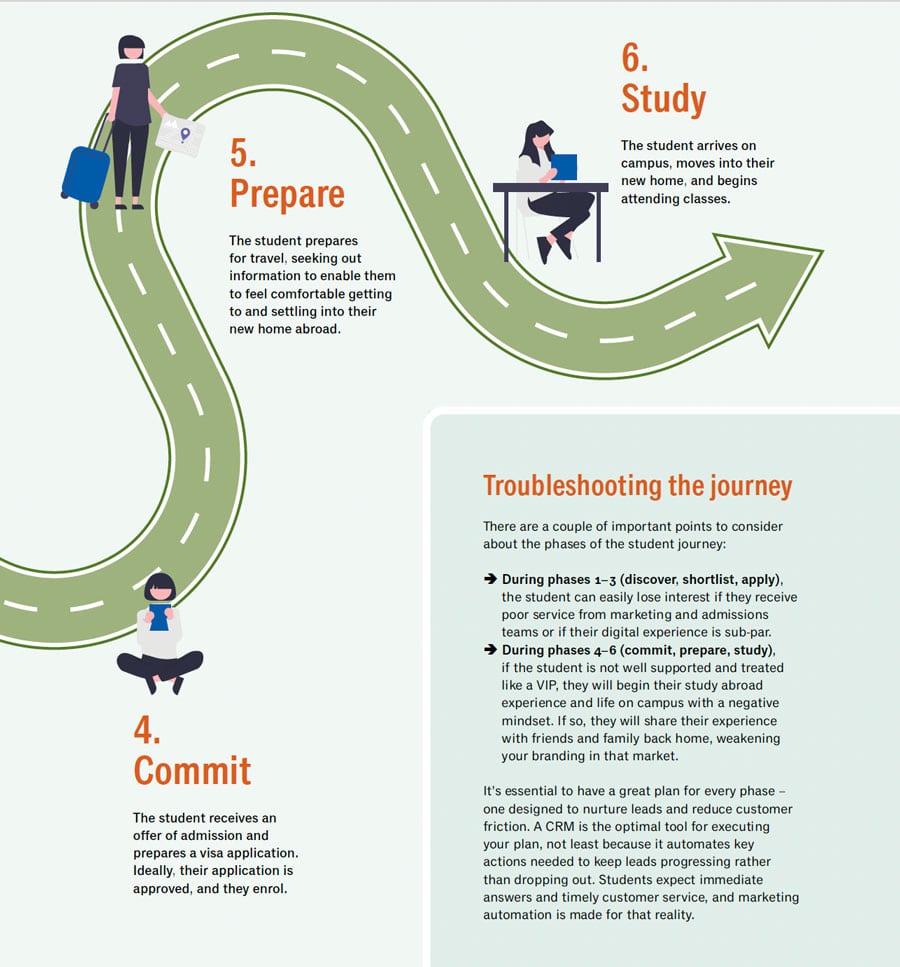Mapping the student journey: Good data, student-centric strategies, and a customised CRM are must-haves
The following article is adapted from the 2025 edition of ICEF Insights magazine, which is freely available to download now.

You are committed to your organisation’s internationalisation goals and targets and dedicated to guiding students to the programmes that suit them best. But commitment and hard work are one thing and having the right supports to achieve results is another.
Is your organisation optimised for international student recruitment? Consider the following questions:
- Where are students discovering your school/university?
- What proportion take the next step (e.g., engage, enquire, apply)?
- What are common pain points for students trying to interact with your institution?
- What are individual students’ goals, priorities, barriers, and interests?
- Which communications and website content do students engage with, and which do they ignore?
If you don’t have these insights, it could be time for your institution or agency to invest in student journey mapping and a customer relationship management system (CRM).
What is the student journey?
The path that students follow from first awareness of an institution to enrolment is called the student journey. It can also be extended to encompass graduation and even employment.
The journey metaphor illustrates how many decisions students make as they proceed towards enrolment, and it prompts institutions and agents to:
- Map out all the brand touchpoints and phases of engagement/activity that can influence a student’s decision to enrol;
- Create a plan to nurture leads at each phase;
- Make customer satisfaction a priority from the time a student indicates interest
to the time they graduate.
Studyportals envisions the student journey as a series of actions that leads take: discover, shortlist, apply, commit, prepare, and study.
That progression is depicted in the following illustrations.


What is a CRM?
Salesforce explains: “A CRM system helps with contact management, sales management, agent productivity, and more. CRM tools can now be used to manage customer relationships across the entire customer life cycle.”
The consulting firm Higher Education Marketing (HEM) elaborates on what a CRM can do:
- Contact management – build and store individual contact profiles, segment them according to your needs, and track your interactions with each one.
- Team management – collaborate, schedule tasks, track leads, and plan workload.
- Communications tools – log and detail communications with contacts via phone, email, SMS, instant messaging, physical meetings, and even social media.
- Reporting – synthesise valuable, granular data on your audience and your own team’s work into reports that can be used to improve your efforts.
Consider what is truly expensive
It’s common for marketing and admissions teams to be told by management that their existing systems (e.g., their original, poorly performing CRM or Excel) have been paid for and must therefore remain in place. This is a huge mistake for at least three reasons:
- Excel does not offer marketing automation.
- An outdated CRM that nobody knows how to use is pointless.
- What is truly expensive is recruiting inefficiently and ineffectively.
When staff lack tools or training to respond immediately and helpfully to prospective student queries, they can easily lose leads through no fault of their own. When they are trained on a well-configured CRM, they can focus on providing the strategic thinking and human touch that remain crucial to customer service.
Alejandra Otero, founder and CEO of education marketing and recruitment consultancy geNEOus, says:
“Viewing [CRM and staff training on it] as a cost is missing the point. Remember, cost is part of an equation. If the cost is outweighed by incoming revenue, it is not a cost; it is an investment that is paying off.”
Common pitfalls
Ms Otero’s company helps institutions and agents to replace inefficient marketing and admissions structures and technologies with new systems and ways of working. These systems are set up with one overarching goal: to track and nurture student leads along the student journey to enrolment.
When brainstorming the process, Ms Otero considered common issues that can derail a recruitment drive:
- Slow responses to student enquiries. According to Keystone Education Group’s State of Student Recruitment (2024) global survey, 85% of students expect a response within 24 hours, preferably through email (70%) or instant messaging (12%, a marked 36% increase over 2023).
- Lack of coordination. Ms Otero explains: “We have seen cases where agents are recruiting diligently and according to an institutional contract, but the admissions team isn’t aware that the agent channel is even being used. The marketing team knows, but this information hasn’t been shared or isn’t visible in the CRM to admissions. The student – after having spoken to an agent – contacts admissions, and admissions tells them they aren’t working with agents. This undermines both the agent’s and institution’s trustworthiness in the market. The silos within an institution should not hinder student experience.”
- Frustrating processes. Asking students to complete many forms with the same basic information, or overly long forms, is a sure way of annoying leads. So is a website chatbot that leaves students with no answers and no idea where to turn to next.
- Lack of personalisation. Are you collecting the right information from students to personalise your communications? Ms Otero notes that when students click on a paid ad or search on a webpage, heated zones where they have lingered can provide data on their top interests (e.g., programmes, scholarships, etc.). Marketing may have this information, but admissions should have it as well for their own interactions with students.
- Limited collection/use of data. Ms Otero says: “Everyone should have data showing where leads are at in the student journey – whether you’re an agent, an admissions officer, or a marketing director. That data is like gold. It reveals opportunities as well as signs that a lead is about to drop off. Data signals where an intervention is required (e.g., a personalised email, an application fee waived, an early admissions offer). Many clients think they need more leads, but better lead management through a CRM is really what is required.”
Customisation is key
When Ms Otero’s team begins to work with a client, the first thing they do is an audit of what data is available (and often not being used) and how marketing and admissions are functioning and interrelating. The team discovers where leads are coming from, enrolment trends, opportunities for better synergies between departments, and common points at which prospects are leaving the enrolment funnel. Ms Otero says:
“You have to know what is and what is not working before coming up with a plan. Every institution is unique, so when we implement a CRM or train staff on new systems, it’s always customised. Everything you do should be for a reason, and each element of a plan must relate to all the other elements.”
A main goal is always to empower people: “It is amazing how much more satisfied and
committed marketing and admissions teams become when they have the right tools to do
their jobs well.”
Student-first thinking
A good way of approaching recruiting and admissions management, says Ms Otero, is to ask: “‘Am I making it easy enough for students to (a) become aware of our brand, (b) interact with our staff and agents, and (c) enrol?’ Part of that is collecting and acting on data, and the other is responding quickly and well to students.
A CRM empowers staff with good data, and it frees them from the impossible task of responding immediately to all queries.”
No need for chaos
Students now have almost endless ways of discovering institutions and deciding whether to enrol. They have far more resources available to them now as they research – just think of all the social media channels they are active on!
Without student journey mapping and associated data, it is next to impossible to properly identify and nurture leads. The result is that leads are poorly managed or even squandered and the ROI on your recruitment effort suffers. A student-centred strategy, backed by an effective CRM that everyone on the team knows how to use, is a reliable path to meeting your recruitment goals and achieving better student outcomes. As staff become adept with new systems, and as students achieve more success, everyone wins.
For additional background, please see:
















